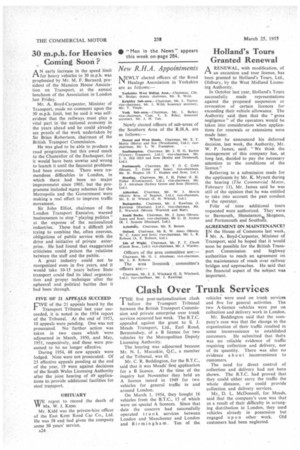30 m.p.h. for Heavies • " Men in the News" appears this week on page 284.
Page 26

If you've noticed an error in this article please click here to report it so we can fix it.
Coming Soon ?
AN early increase in the speed limit for heavy vehicles to 30 m.p.h. was prophesied by Mr. M. F. Barnard, president of the Mansion House Association on Transport, at the annual luncheon of the Association in London last Friday.
Mr. A. Boyd-Carpenter, Minister of Transport, made no comment upon the 30 m.p.h. limit, but he said it was selfevident that the railways must play a vital part in the national economy in the years ahead and he could already see proofs of the work undertaken by Sir Brian Robertson, chairman of the British Transport Commission.
He was glad to be able to produce a road programme, but this owed much to the Chancellor of the Exchequer, for it would have been unwise and wrong to launch it until the financial problems had been overcome. There were tremendous difficulties in London, in which there had been no major improvement since 1905, but the programme included many schemes for the Metropolis and the Government were making a real effort to improve traffic movement.
Sir John Elliot, chairman of the London Transport Execuive, warned businessmen to stop " playing politics" at the expense of the nationalized industries. These had a difficult job trying to combine the, often onerous, obligations of public service with the drive and initiative of private enterprise. He had found that exaggerated criticisms could poison the relations between the staff and the public.
A great industry could not be reorganized even in five years, and it would take 10-15 years before State transport could find its ideal organization and proper technique after the upheaval and political battles that it had been through.
FIVE OF 21 APPEALS SUCCEED LIVE of the 21 appeals heard by the I Transport Tribunal last year succeeded, it is noted in the 1954 report of the Tribunal. At the end of 1953, 10 appeals were pending. One was not prosecuted. No further action was taken in two cases which were adjourned in March, 1950, and May, 1951, respectively, and these were presumed to be no longer effective.
During 1954, 48 new appeals were lodged. Nine were not prosecuted. Of 25 effective appeals pending at the end of the year, 19 were against decisions of the South Wales Licensing Authority after the joint hearing of 49 applications to provide additional facilities for steel transport.
























































































